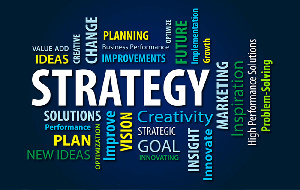Opinions of Sunday, 28 November 2021
Columnist: Dr Brian Reuben
The Strategic Organization
I have a duty to empower people, to transform De Beers Consolidated Mines such that each and every manager is empowered, and they have the freedom to exercise their creativity for the good of the business and themselves - David Noko
Many companies have a big problem with meeting their goals. For example, research shows that on the average, companies deliver only 50% to 60% of the financial performance that their strategies and sales forecasts have promised.
These companies had the discipline to design a strategy and even implement the strategy yet failed at meeting the goals and sales forecast based on the strategy. In another study of 163 CEOs by Forbes Insights it was discovered that nearly a third of all business strategies never reach their mark.
Now understand clearly, effectively executing on strategy is the only basis for expecting a superior market performance because strategy gives an organization the ability to create a competitive advantage.
Managers clearly understand that, as demonstrated in the interest the subject of strategy generates among business executives. A search with the keyword 'strategy' on www.amazon.co.uk generates over 100,000 results. A search with 'strategy' as the keyword on Google generates 2,270,000,000 search results. This shows how much interest managers whether of small, medium or large organizations devote to strategy.
One would expect that such level of interest will translate to knowledge leading to better decision making, which should result in superior performance. But the results suggest otherwise.
According to an Effectory research with some 300,000 responses from companies worldwide, less than 50% of employees say they understand their firm’s strategy. In another study by Booz & Company, survey of more than 1,800 executives, 56% say their biggest challenges are making daily decisions in line with strategy and allocating resources in a way that supports the firm’s strategy. The effect of these findings are reflected in another study by Marakon which showed that less than 20% of even well-formulated strategies are executed successfully and, on average, firms deliver only 50% of the financial performance their strategies promise.
So we can identify two reasons why organizations fall short of their performance expectations: lack of clarity about the business strategy and ineffective execution. Of course it is impossible to expect effective execution when the people lack clarity about the strategy. Solving the problem of clarity about the strategy is the easy part. Effective communication can quickly take care of that when leaders learn how to communicate, which is something very different from what most leaders do. You see, effective communication is very different from what a lot of leaders can even think about.
Davina Jones* is the CEO of a London based professional services firm who understands the importance of communication. The management team met once a week and she ensured they began by reciting their company strategy and their key priorities for the year. She was convinced her efforts paid off when an in-house survey showed 84% of her staff agreed that they have clarity on the company’s top priorities. But the 'clarity' could not translate to performance. So she engaged a consulting firm to carry out a survey. To her surprise, less than one-third of her employees could name even two of the company’s top five priorities in their own words.
The reason for this is simple. To start with, most leaders measure communication in terms of input. Nothing can be more deceptive than that. Effective communication is measured in terms of feedback. This goes beyond the ability of your people to repeat what they've been taught but their ability to make decisions based on what's been communicated. Understanding is measured in terms of actions. So when people understand the business strategy they will execute it.
The key is to become a communicating organisation. A communicating organisation is the organisation that communicates. It's not just about the tools, it’s more about the attitude. It’s about a culture of willingness to pass information in a timely, coherent and comprehensive way to ensure people have the ability and passion to make the right decisions in a timely manner. If you want to know more about communicating organizations, please request the workbook on the Communicating Organization through admin@brianreuben.com
So if strategy is clear, people can make decisions that's in alignment with it. The result will be effective execution. To achieve this the CEO has to rethink his/her responsibility. There will have to be a commitment to the success of the people ensuring barriers are removed for them so that they can be successful in what they do. Engaging with Managers at all levels to ensure that performance objectives are in alignment with the strategic direction of the organization is one of the most effective ways successful leaders achieve this. This is an approach that has worked for organisations like AlliedSignal (now Honeywell), Google and others.
Effective Execution Is Not Enough
Superior performance is the result of effectively designing, implementing and executing strategy. Organizations like Kodak, Nokia, IBM, Burberry, Blockbuster, Google etc rose to dominate their industry as a result of the competitive advantages created by their strategy. Take Kodak for example, at the height of their success in 1996, it held two-thirds of global market share with a revenue of nearly $16 billion. Yet between 2003 to 2011, Kodak shed 47,000 jobs, 13 manufacturing plants and 130 processing labs. It could no longer make an annual profit by 2004 and its cash reserves were soon depleted.
What happened to Kodak? Well, the same thing that happened to other organisations that failed. Growth happens as a result of competitive advantage resulting from strategy. Remaining a growing and profitable business also depends on remaining great at design, implementation and execution of the strategy.
The implication is that strategy execution is not something to put on and off. On the contrary, it is meant to be a lifestyle, a culture and an attitude of the organization. Great Organizations are not just great at executing strategy, they build a strategic organization. A strategic organization is structured to support the choices and decisions consistent with the strategic direction of the organization. It is the organization designed to execute.
Capital One is listed among the 100 largest banks in the United States. It's a bank holding company which runs more than 50,000 new product or market segment tests each year in its quest to drive the net present value of the firm higher. In the process, it has built a valuable proprietary database (an average of one hundred pages single spaced on every adult in the USA) that also makes it smarter in seeking out new profit opportunities. This ability to move faster than competitors gives Capital One a clear competitive advantage.
Capital One generates 50,000 new credit card product ideas every year – each requires trade-offs between marketing, risk management and operations. These decisions are made not in the executive suites but by commercial teams on the front line. The rules are clear on what decision rights these teams have and their actions are tracked carefully, but they are empowered to make choices on which customer and product groups to serve. That is a classic example of a Strategic Organization. Execution works in the natural course of work in strategic organizations because the mechanism for execution is an inbuilt system. So people don't try to be strategic, the system is!
There are three fundamental ideas that define a strategic organization:
● Structural design
● Communication system
● Reward system
To successfully generate and test over 50,000 new credit card product ideas each year, Capital One's structure has a self-adjusting mechanism. When the frontline employees come up with ideas, they have the support of the management to organize themselves and begin the process of implementing them. They can form a team, determine what skills are needed and even suggest a reward system with management only approving.
Like Google, the role of management at Capital One is not to come up with new credit card ideas but to ensure their people have the liberty, the strength and motivation to do that. Capital One's competitive advantage comes from its ability to out innovate its competition. To achieve that requires a system that enables people to play around with ideas and get together with their friends to turn ideas into products. Capital One is structured to make innovation easy. This is how Capital One built a strategic organization.
Consider Google, a very innovative company yet it has no innovation department. The idea is to create a culture of innovation rather than a department charged with innovation while everyone else can do what they like. This is important because like Capital One, Google's strength lies in moving ahead of the competition.
There are two basic ways successful organizations sustain their advantage: developing something the competition cannot replicate or to continuously improve faster than the competitors. Continuous improvement is behind most successful companies' ability to sustain their advantage because it's almost impossible to create something that no competitor can match.
Google, Capital One and other successful organizations understand that and have designed organisational structures that make innovation a way of life. Among Google’s nine principles of innovation are “ship and iterate”, produce products very quickly, get them to market as a prototype if necessary and use feedback from users to improve them; and “failing well”, eliminating products that do not meet expectations but rather than being a stigma, instead generate pride. These ideologies make innovation a way of life at Google.
Notice how CEO of Google, Sunda Pichai summarized this approach to execution in his thought provoking speech at the Indian Institute of Technology-Kharagpur: When you’re trying to run something at the scale of Google, we have now over 60,000 people and…you rely on other strong leaders. A lot of what I do is… I have an outstanding leadership team. It’s learning to let go and really empowering people at all levels of the organisation, and trusting them to do the right thing.
As a leader, a lot of your job is to make those people successful. It’s less about trying to be successful (yourself), and more about making sure you have good people and your work is to remove that barrier, remove roadblocks for them so that they can be successful in what they do.
That is how organizational structure drives innovation in strategic organizations.
Communication system
Building a strategic organization requires more than communication, it requires a culture of communication. Li and Fung is a leading name in the fashion retailing industry where winning requires stocking only the hottest selling lines to maximize sales and avoid costly end-of-season mark-downs. Success requires a supply chain that provides an instant refill capability rather than waiting many months for supplies. Winning with this market approach requires an intelligent communication system that feeds information from the market in an instant. You can't rely on people to communicate well here if you are planning on winning, you need a system that makes them communicate.
For Li and Fung, their advantage lies in their ability to develop an exceptional supply chain management system that gives them the power to respond faster than competitors in fashion production in the most cost effective way. For the company to profit, it has to supply what the markets want. But what is the most effective way of knowing this? Well the small retail chains that deal directly with the buyers need to stock what the markets ask for or go bankrupt. But since speed, coming to the market first is of essence, they are compelled to get the information and share it with the supplier that has the capability to deliver. They are thus compelled to communicate. That's what a communicating system does.
A fundamental component of a strategic organization is a communicating system and as stated earlier the problem lies with how leaders manage communication. The result of effective communication is a clarity that results in conviction of what is right. All bad decisions result from lack of understanding about the right answer to provide or the right step to take. So the focus of communication should be enlightenment and not the ability to do a recitation of what was said. True communication enlightens the heart not the head.
In the case of Li and Fung, the small chain retailers know what is good for their business. They clearly understand they have to stock the hottest selling line fast enough. That's how they think and that is because they have understood that. That is what any business aspiring to become strategic must ensure.
The key is to be clear about your strategy yourself as a leader. Clarity of approach is the foundation for creating a system that communicates. This clarity means you possess a complete picture of your strategy. A complete picture is that not limited by ignorance, doubts and I'll feelings.
Clarity of approach will inspire a strategic description of duties and job responsibilities in a way that inspires the people and drives creativity naturally. Because everyone needs everyone, people ask the right questions, provide the right answers, seek the right support because they have the conviction that comes from clarity.
So the question becomes whether or not you are clear about what your strategy is, the spirit of your strategy and the purpose of your strategy. Do you know how and what makes your strategy relevant? Do you know the market value of your strategy? If you lack clarity on these you cannot expect your people to be clear and if they are unclear, they cannot communicate. And as communication struggles, performance struggles too.
Communication means people are sharing ideas in a timely and useful manner. The truth is every organization communicates. Some communicate confusion, insincerity and deception. Communicating ideas consistent with the strategic direction of the organization among stakeholders- shareholders, employees, customers and others happens as a result of a carefully thought out system that everyone understands and is proud of.
Reward System
What gets measured gets valued and what gets valued gets rewarded. What gets rewarded affects productivity. In strategic organisations rewards are designed to motivate the right attitude and actions in the workplace. Most organisations are designed to reward people for their normal day job. Personal initiatives, innovative thinking, personal development could go unrewarded and even unnoticed yet strategic organizations are designed to recognize and honor them. Except the organization recognizes and rewards the attitudes and activities the strategy requires to work, the organization isn't being strategic.
In strategic organizations, management is very clear about what attitude and behavior that drives performance. Actions and attitudes not consistent with that are frowned at.
It is the day to day activities of everyone in the organization that creates value or destroys it. The organization is strategic if the activities that drive performance are identified and rewarded. Capital One rewards it's people for seeking out high net present value customers. It runs over 50,000 credit card ideas yearly to find them. Because the people are rewarded for it, they take it seriously. This appears simple but it's not. In the case of UK telecommunications company Energis, it's strategy was focused on large customers with complex telecommunications need but the company instead rewarded sales people based on sales volume.
Since it takes many years to build relationships with the target audience which their strategy defined, they focused on high-volume, low-margin commodity services. At the end they drifted away from the strategy and went defunct.
Our actions as human beings are often driven by a desire to gain a reward. The incentive theory suggests that behavior is motivated by a desire for reinforcement or incentives. With this in mind, successful organizations structure their organization in a way the reward system drives the actions consistent with their strategy. This is what Capital One achieved. By building a system that encourages the attitudes that support their competitive advantage.
For U.S based Nucor Corporation the key source of competitive advantage is its ability to operate steel mini-mills more cost effectively than the competition and. It rewards its people handsomely for achieving this.
The stroke can be different for every organization but the key is to be clear about what advantage supports your strategic direction and align your reward system with actions and attitudes that support your advantage. This makes the consequences of your people's everyday interaction the desired organisational results. This is the pathway to superior performance.
Dr Brian Reuben works with governments and organisations around the world to strengthen institutions for superior performance. He convenes international and regional events that inspire conversations, connections and collaborations among leaders in the pursuit of their goals.
*Davina Jones is not the real name of the Executive.
Entertainment










